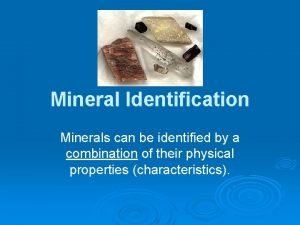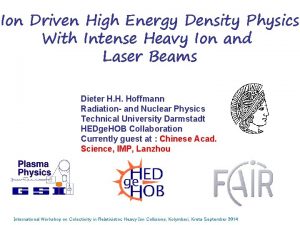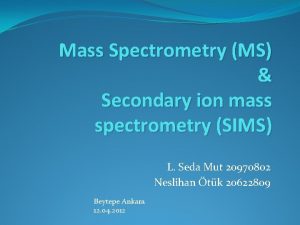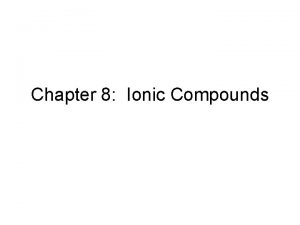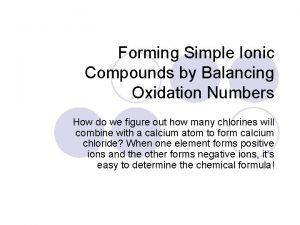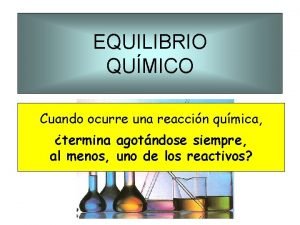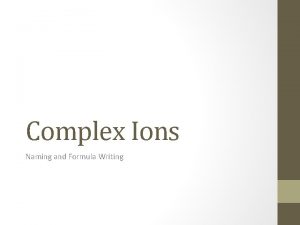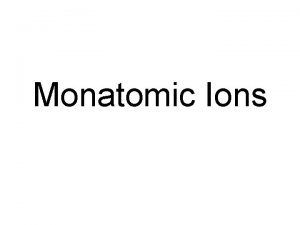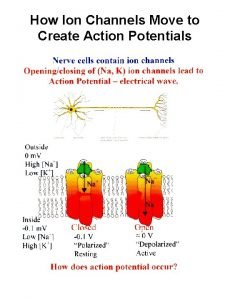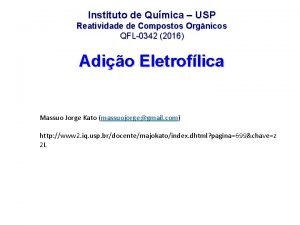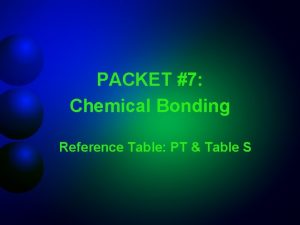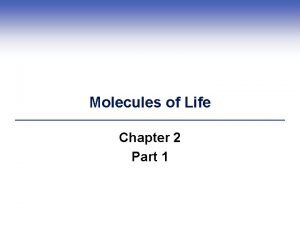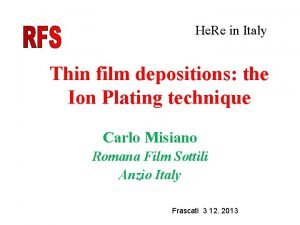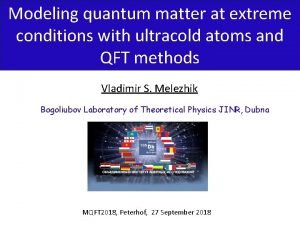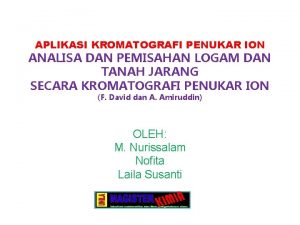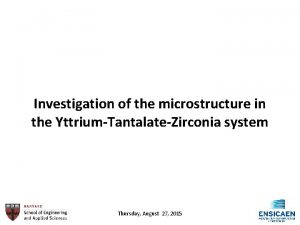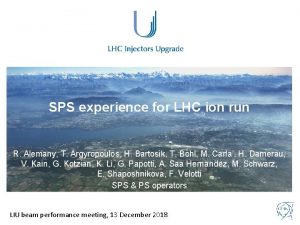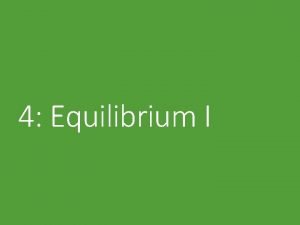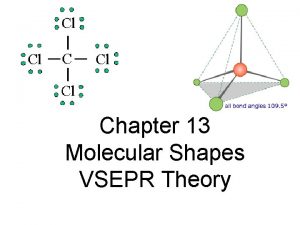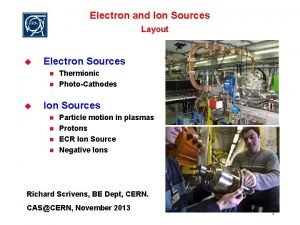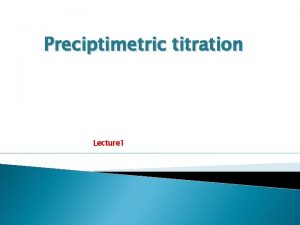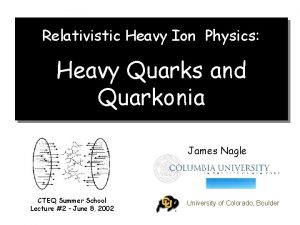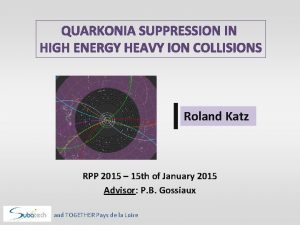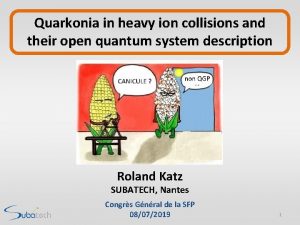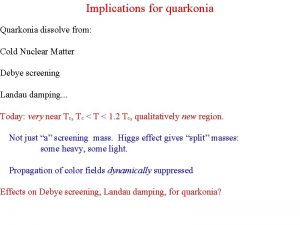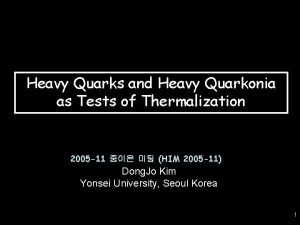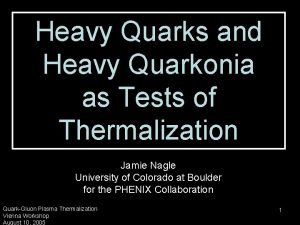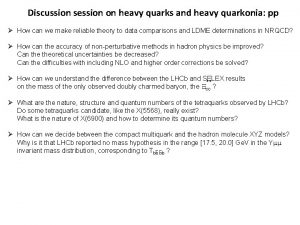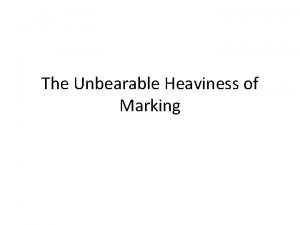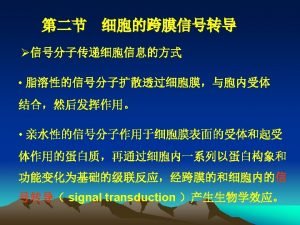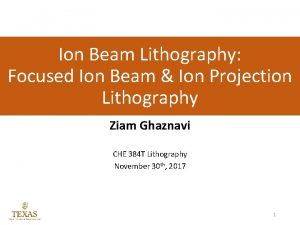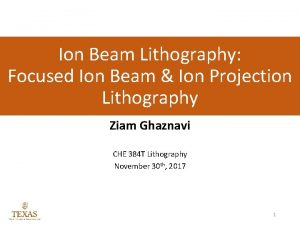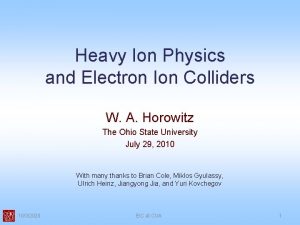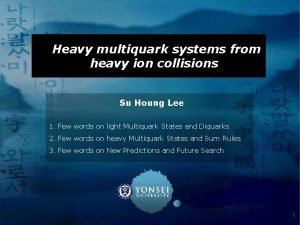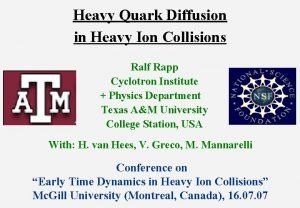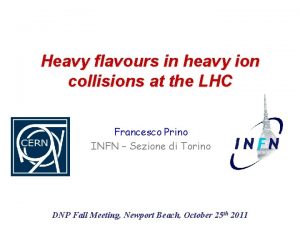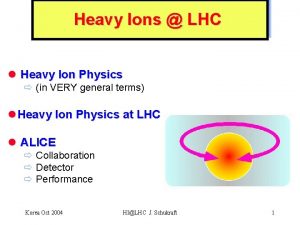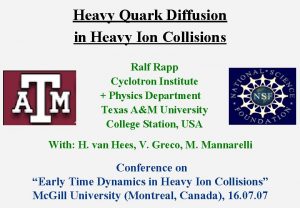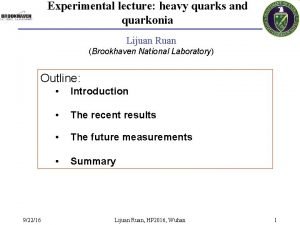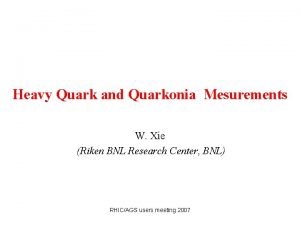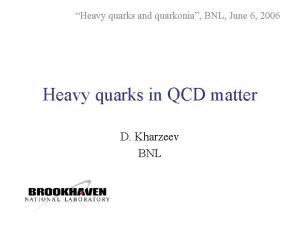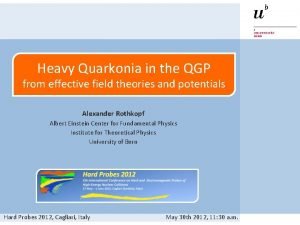J Heaviness of Heavy Quarkonia in Heavy Ion























![Trends in <p. T 2> [0 -5 Ge. V/c] PHENIX e+e- PHENIX m+m- Modest Trends in <p. T 2> [0 -5 Ge. V/c] PHENIX e+e- PHENIX m+m- Modest](https://slidetodoc.com/presentation_image_h2/93897eafa609806dcaacba1b89789e32/image-24.jpg)








- Slides: 32

J/ Heaviness of Heavy Quarkonia in Heavy Ion Collisions Jamie Nagle University of Colorado, Boulder For the PHENIX Collaboration Winter Workshop Big Sky, MT February 11 -18, 2007 1

2

“Of Major Import” V(r)/ Lattice QCD calculation r cc Cold Matter Path = L 3

~40% feedown from C, ’ (uncertain fraction) configuration of ccbar state absorption d+Au constraint? shadowing or coherence The J/ Puzzle Data – SPS, PHENIX, STAR, LHC… Need high statistical & systematic accuracy CNM PHENIX J/ Suppression: • like SPS at mid-rapidity • stronger at forward rapidity with forw/mid ~0. 6 saturation • <p. T 2> centrality indep. CGC - less charm at forward rapidity comovers more mid-rapidity suppression Sequential screening C, ’ 1 st, J/ later lattice & dynamical screening J/ not destroyed? large gluon density destroys J/ ’s Slide from Mike Leitch ! Regeneration & destruction less suppression at mid-rapidity narrowing of p. T & y J/ flow Regeneration (in medium? ) large charm cross section Charm d. E/dx & flow 4

What can PHENIX measure? J/ dielectrons |y| < 0. 35 Excellent PID Good mass resolution J/ dimuons |y| = 1. 2 -2. 2 Reasonable PID Reasonable mass resolution Excellent acceptance Low signal to background 5

PHENIX Data Sets Year Ions s. NN Luminosity Status J/ (ee + mm) 2001 Au-Au 200 Ge. V 24 b-1 Central 13 + 0 [1] 2002 p-p 200 Ge. V 0. 15 pb-1 + 1 muon arm 46 + 66 [2] 2002 d-Au 200 Ge. V 2. 74 nb-1 Central 360 + 1660 [3] 2003 p-p 200 Ge. V 0. 35 pb-1 + 2 muon arms 130 + 450 [3] Au-Au 200 Ge. V 240 b-1 Final ~ 1000 + 4500 [5] Au-Au 63 Ge. V 9. 1 b-1 Analysis ~ 13 p-p 200 Ge. V 324 nb-1 Cu-Cu 200 Ge. V 4. 8 nb-1 Preliminary ~ 2300 + 10000 [4] Cu-Cu 63 Ge. V 190 mb-1 Preliminary ~ 60 + 200 p-p 200 Ge. V 3. 8 pb-1 Final ~ 1500 + 8000 [6] 2004 2005 [1] PRC 69 (2004) 014901 [2] PRL 92 (2004) 051802 [3] PRL 96 (2006) 012304 [4] nucl-ex/0510051 [5] nucl-ex/0611020 (submitted to PRL) [6] hep-ex/0611020 (submitted to PRL) 6

Signal Extraction Proton-Proton Data 7

Gold-Gold Central Case J/ ee Au. Au 10% Central S/B ~ 0. 25 J/ mm Au. Au 20% Central S/B ~ 0. 1 Detailed event mixing background subtraction, modified log likelihood fitting, and careful systematic error determination. * No signal in North Muon Arm 0 -10% central Au. Au (only signal in South Arm). Detector occupancy more than 2 x HIJING! PHENIX CDR expected S/B>1. 8

Systematic Errors For proton-proton through mid-central Gold-Gold reactions, reasonably small systematic errors. For central Gold-Gold, high occupancy and background in the muon spectrometers yield somewhat higher systematic (24% on signal extraction and 16% on efficiency determination). Additional systematic for RAA on binary collision estimate ~28 -10% (peripheral central). s/s (statistical errors) = 10 -20% (peripheral central). 9

The Unadulterated Data! nucl-ex/0611020 submitted to PRL 10

Ratio Blue / Red Nuclear Suppression Factor Still Just the Data! Collision Centrality ( More Central) 11

Simple Theory Assume J/ is at rest and a static medium (no time evolution). If local density (d. ET/dy or d. Np/dy) > threshold then no J/. J/ Note it does include a Woods-Saxon Density Profile ! Predictions: (1) Much larger J/ suppression at RHIC compared with SPS. (2) Larger J/ suppression at mid-rapidity where local density is highest. 12

Statistical and Systematic Comparison PHENIX data at 200 Ge. V is quite surprisingly compatible with NA 50 data at 17. 2 Ge. V ! PHENIX data at forward rapidity shows a significantly stronger suppression. 13

Theoretical Explanations I. Simple explanation (naturalness) II. Cancellation of multiple effects (unnaturalness? ) * Note that Occam’s razor does not tell you the right answer, but it does give some 14 insight into burden of proof.

Naturalness (Plan A) What if all suppression is due to cold nuclear matter breakup? It is the same cold nucleus at both energies. NA 50 Experimental Data Aside (i) There are no non-monotic changes in derivatives (ii) This “second drop” has been acknowledged by NA 50 as an experimental artifact. Calculation by Qiu, Vary, Zhang (PRL 2002). Assumes q 2 between c and c pair increases linearly with cold nuclear matter path L from multiple scattering. 15

Naturalness (Plan A) A more detailed analysis of coherent multiple scattering effects in the Drell-Yan process also found a constant q 2 a L, provided one considers at each twist only the contribution that gives the largest q 2 change (i. e. just a shift up in q 2). The coherence assumption turns out to be critical to getting large suppression. Including fluctuations from incoherence ruins the picture. Note the crossing times for cold nuclear matter: t ~1. 0 fm/c at SPS t ~0. 1 fm/c at RHIC 16 A. Glenn, D. Molnar, JN, Phys. Lett. B 644: 119 -125, 2007.

Naturalness (Plan B) Quark or Gluon has to propagate through the medium. Large opacity surface emission and lack of sensitivity. q c c Imagine ccbar propagating through medium, or medium propagating through ccbar. If c or cbar scatters, then J/ correlation lost. Why not similar biased emission and lack of density sensitivity? 17

Example: MPC Dynamics y (fm) Molnar Parton Cascade Work by A. Glenn, D. Molnar, JN Gold-Gold b=8 fm simulation. Embed charm into the initial state using PYTHIA kinematics. (Lower) Initial position of charm quarks that had no collisions through the time evolution. y (fm) (Upper) Initial position of all charm quarks from slice along z=0. x (fm) 18 x (fm)

Similar Trends (? ) 19

Cancelling Effects (Plan a)? NA 50 at SPS (0<y<1) PHENIX at RHIC (|y|<0. 35) PHENIX at RHIC (1. 2<|y|<2. 2) Cold nuclear matter effect smaller at RHIC, and thus hot nuclear matter effect must be larger to match RAA. RHIC CNM effects ( abs = 0, 1, 2 mb at y=0, y=2) R. Vogt et al. , nucl-th/0507027 SPS CNM effects ( abs = 4. 18 mb) NA 50, Eur. Phys. J. C 39 (2005): 355 Need better constraint at RHIC. Also, what might the physics behind a different cold nuclear matter effect be? 20

Cancelling Effects (Plan b) Original J/ suppressed. Grandchamp, Rapp, Brown PRL 92, 212301 (2004) nucl-ex/0611020 R. Rapp et al. (for y=0) PRL 92, 212301 (2004) R. Thews (for y=0) Eur. Phys. J C 43, 97 (2005) N. Xu et al. (for y=0) nucl-th/0608010 Bratkovskaya et al. (for y=0) PRC 69, 054903 (2004) A. Andronic et al. (for y=0) nucl-th/0611023 And many other calculations…. Compensated for by recombination of originally uncorrelated c and c. 21

Recombination Prescription OEM calculation Most recombination of pairs close in momentum space: σ (mb) y < 0. 5 p. T < 1 Ge. V/c ECM (Ge. V) |Ypair| < 0. 35 22 p. T <σ> (mb) Note that this example cross section (OEM) has significant uncertainties. One also needs the charm yield and distribution and the spacetime evolution of the medium. Phys. Rev. C 73 (2006) 014904 y Thus, recombination J/ expected to contribute mostly at low p. T and fall off away from mid-rapidity. R. L. Thews, M. L. Mangano

Initial Scattering versus Recombination Initial state multiple scattering gives an expected increase in <p. T 2>. This is usually calibrated from d-Au data. Recombination formation reduces <p. T 2> since most available charm quarks are at low p. T to find partners. Warning: The PHENIX Run-3 results implied a large increase in d-Au <p. T 2>. The Run-3 p-p results have been revisited and it was found that the systematic error was underestimated. A full re-analysis of the d-Au data is underway to determine 23 how this effects our interpretation of that data set.
![Trends in p T 2 0 5 Ge Vc PHENIX ee PHENIX mm Modest Trends in <p. T 2> [0 -5 Ge. V/c] PHENIX e+e- PHENIX m+m- Modest](https://slidetodoc.com/presentation_image_h2/93897eafa609806dcaacba1b89789e32/image-24.jpg)
Trends in <p. T 2> [0 -5 Ge. V/c] PHENIX e+e- PHENIX m+m- Modest growth in <p. T 2> with the quantity integrated from 0 -5 Ge. V/c only. Note the new high statistics proton-proton reference. New p+p reference (|y|<0. 35): New p+p reference (|y| in [1. 2, 2. 2]): 24

More Data = More Constraints Transverse Momentum Dependence of the Suppression 25

Open Charm Input Any recombination model must also match the charm distribution. nucl-ex/0611018 submitted to PRL J/ Note that J/ get contributions from charm at ½ J/ p. T. And charm yields electrons with ~ 0. 7 x D meson p. T. Non-photonic electrons (from heavy flavor decay) 26

“Does the Charm Flow at RHIC? ” “If the plasma is opaque enough to direct the J/ or its precursor cc into azimuthally asymmetric flow, then a v 2 measurement of J/ could serve as a smoking gun. ” 27 RHIC II White Paper

My Recombination Prediction NA 38 / NA 50 J/ At the CERN-SPS the ’ is suppressed much more than the J/. This is attributed to the ’ larger physical size and smaller binding energy. ’ Prediction: ’ Suppression Pattern for RHIC 28

Forward Rapidity Puzzle? Recombination could lead to narrowing of J/ rapidity distribution, though it depends on the flatness of the initial charm rapidity distribution. Another explanation may come from nuclear modification of the initial parton distribution functions. Low x 2 ~ 0. 003 (shadowing region) Shadowing Rd. Au Anti Shadowing 0 mb x 3 mb Eskola et al. NPA 696 (2001) 729 29

Shadowing / Saturation K. L. Tuchin hep-ph/0402298 Open charm yield in Au+Au @ 200 Ge. V =0 =2 In Au+Au at forward rapidity, one is sensitive to both low x and high x partons. Calculations must be constrained by all d-Au data (backward, mid and forward rapidity) ! 30

Heavy Outlook Exciting new results on heavy quarkonia at RHIC are of major import and potentially profound, though not easily digested. On the experiment side, we must have measurements of multiple states (J/ , ’, C, U(1 s, 2 s, 3 s)) ! Theory needs full dynamical evolution matching both open and closed charm in a consistent picture (good progress here). Less drawing lines through points. 31 Exciting future with more results from SPS, RHIC, and LHC!

Back to the Salt Mines ! RHIC II LHC 32
 This determines the heaviness of a mineral
This determines the heaviness of a mineral London forces
London forces C6h12 fuerza intermolecular
C6h12 fuerza intermolecular Qumica
Qumica Fuerzas dipolo-dipolo ejemplos
Fuerzas dipolo-dipolo ejemplos Heavy ion
Heavy ion Ratey algebra 2
Ratey algebra 2 Mass spectrometry positive and negative ion mode
Mass spectrometry positive and negative ion mode Chapter 8 ionic compounds
Chapter 8 ionic compounds What element is it
What element is it Equilibrios homogéneos
Equilibrios homogéneos Tabla de oxidantes y reductores
Tabla de oxidantes y reductores Naming complex ions
Naming complex ions Monatomic ions periodic table
Monatomic ions periodic table Ion channels
Ion channels Qumica
Qumica Draw calcium atom
Draw calcium atom Which diagram best illustrates the ion molecule attractions
Which diagram best illustrates the ion molecule attractions Chlorine charge ion
Chlorine charge ion Aubr2 nomenclatura
Aubr2 nomenclatura Ion plating process
Ion plating process Pseudopotential
Pseudopotential Aplikasi kromatografi penukar ion
Aplikasi kromatografi penukar ion Alkene can be formed from carbonium ion by
Alkene can be formed from carbonium ion by Surrey ion beam centre
Surrey ion beam centre Biografia lui ion luca caragiale
Biografia lui ion luca caragiale Lewis structures represent the
Lewis structures represent the Fischione 1010 ion mill
Fischione 1010 ion mill Ion run it
Ion run it Write note on common ion effect
Write note on common ion effect Acetate ion molecular geometry
Acetate ion molecular geometry Magnetic mirror
Magnetic mirror Common ion effect explained
Common ion effect explained
